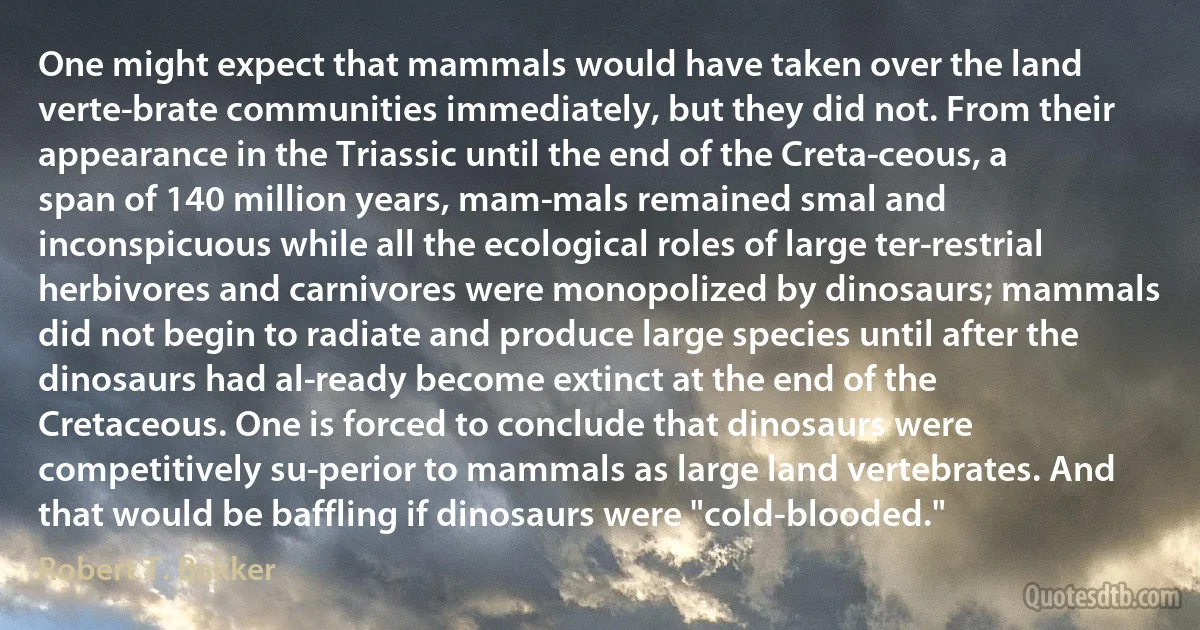
One might expect that mammals would have taken over the land vertebrate communities immediately, but they did not. From their appearance in the Triassic until the end of the Cretaceous, a span of 140 million years, mammals remained smal and inconspicuous while all the ecological roles of large terrestrial herbivores and carnivores were monopolized by dinosaurs; mammals did not begin to radiate and produce large species until after the dinosaurs had already become extinct at the end of the Cretaceous. One is forced to conclude that dinosaurs were competitively superior to mammals as large land vertebrates. And that would be baffling if dinosaurs were "cold-blooded."
Robert T. BakkerRelated topics
appearance baffling begin end expect land large might produce ready take while yearsRelated quotes
To conclude: there are two well-known minor ways in which language has mattered to philosophy. On the one hand there is a belief that if only we produce good definitions, often marking out different senses of words that are confused in common speech, we will avoid the conceptual traps that ensnared our forefathers. On the other hand is a belief that if only we attend sufficiently closely to our mother tongue and make explicit the distinctions there implicit, we shall avoid the conceptual traps. One or the other of these curiously contrary beliefs may nowadays be most often thought of as an answer to the question Why does language matter to philosophy? Neither seems to me enough.

Ian Hacking
Ann Druyan suggests an experiment: Look back again at the pale blue dot of the preceding chapter. Take a good long look at it. Stare at the dot for any length of time and then try to convince yourself that God created the whole Universe for one of the 10 million or so species of life that inhabit that speck of dust. Now take it a step further: Imagine that everything was made just for a single shade of that species, or gender, or ethnic or religious subdivision. If this doesn't strike you as unlikely, pick another dot. Imagine it to be inhabited by a different form of intelligent life. They, too, cherish the notion of a God who has created everything for their benefit. How seriously do you take their claim?

Carl Sagan
Being fresh out of college, I found myself in the typically feminine dilemma of carving out for myself in a male world a way of life appropriate to a young woman of taste, cultivation and sensitivity. There must be nothing crass-like work. However, a girl must survive. So, after a cool appraisal of the social scene, I finally hit upon an excellent-paying occupation, challenging to the ingenuity, dealing on one's own terms with people and affording independence, flexible hours, great stability and, most important, a large amount of leisure time, an occupation highly appropriate to female sensibilities. I contemplate my good fortune as I begin work for the day: "Pardon me, Sir, do you have fifteen cents?"

Valerie Solanas
In manufactures, a very small advantage will enable foreigners to undersell our own workmen, even in the home market. It will require a very great one to enable them to do so in the rude produce of the soil. If the free importation of foreign manufactures were permitted, several of the home manufactures would probably suffer, and some of them, perhaps, go to ruin altogether, and a considerable part of the stock and industry at present employed in them, would be forced to find out some other employment. But the freest importation of the rude produce of the soil could have no such effect upon the agriculture of the country.

Adam Smith
.. Your Lordship [Dartmouth], I am sure, will be sensible of the dress thus far, but I defy any but a painter of some sagacity (and such you see I am, my Lord) to be well aware of the different effects which one part of a picture has upon another, and how the eye may be cheated as to the appearance of size, &c., by an artful management of the accompaniments. A tune may be so confused by a false bass that if it is ever so plain, simple, and full of meaning it shall become a jumble of nonsense, and just so shall a handsome face be overset by a fictitious bundle of trumpery of the foolish painter's own inventing.... Lady Dartmouth's [second/repainted] picture will look more like and not so large when dressed properly..

Thomas Gainsborough
